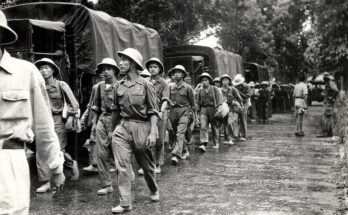Introduction

The 1950s in the United States is often remembered as a decade of conformity, prosperity, and burgeoning suburbia. It was an era marked by a shift in cultural values, social structures, and economic prosperity that transformed how Americans lived. This post-war period saw the emergence of the American Dream in its most material and idealized form—one of white picket fences, perfect families, and the promise of comfort and stability. Let’s take a journey back to this fascinating era and explore how the 1950s defined the modern suburban lifestyle.
The Boom After the War
The End of World War II and Economic Recovery
The aftermath of World War II brought immense changes to the United States. As the war ended, returning soldiers were greeted with the prospect of a booming economy. Government initiatives like the GI Bill provided financial support for education, home loans, and business opportunities, leading to an unprecedented surge in homeownership. This economic boost created a generation eager to start anew, shaping the rise of suburbia.
The Rise of Suburban Living
The 1950s marked the beginning of suburban sprawl. Families moved from cramped city apartments to spacious suburban homes, driven by a desire for space, peace, and a sense of community. The development of Levittown, Long Island one of the first planned communities served as a model for the suburbs that would spring up across the country. These developments were affordable, with standardized house designs and mass production techniques that made homeownership accessible to the middle class.
Also Read: The Untold Story of the 1993 Lagos Bombing: Uncovering the Truth
The American Dream Redefined
The Ideal Family Home
In the 1950s, owning a home became synonymous with the American Dream. The quintessential 1950s home was a single family house with a front lawn, a garage, and often three bedrooms. The floor plans were open and spacious, reflecting a new ideal of family living. The suburbs offered a sanctuary from the pressures of urban life, providing space for children to play freely and families to grow.
Consumerism and the Middle Class
The post-war boom saw a rise in consumerism, with Americans buying more than ever before. Household appliances, cars, and television sets became symbols of success. The availability of credit and easy financing options made it possible for many to purchase goods that would have been out of reach a decade earlier. This era saw the development of “planned obsolescence,” where products were designed to become outdated quickly, fueling the economy’s growth and the desire for the latest gadgets.
The Role of Television in Shaping Suburban Life
The Television Revolution
Television played a crucial role in shaping the 1950s American Dream. With families spending evenings in front of the TV, shows like “Leave It to Beaver” and “The Adventures of Ozzie and Harriet” became cultural touchstones, portraying idealized suburban life. These shows presented a clean, orderly world where families were always happy, the husband worked, and the wife managed the home. Television set the standard for how Americans thought about success and happiness.
The Impact on Consumer Culture
Television advertising exploded in the 1950s, influencing how Americans lived and what they aspired to own. Commercials for products like cars, appliances, and household goods flooded the airwaves, promising convenience, happiness, and the American Dream. This era was marked by a new kind of prosperity, where material goods were seen as the path to fulfillment and status.
Social Changes and Challenges
The Racial Divide in Suburbia
While the suburbs were portrayed as a melting pot of diverse families, the reality was often different. Many neighborhoods were racially and economically segregated, with restrictive covenants that prevented certain groups, particularly African Americans and immigrants, from buying homes. The suburbs became symbols of privilege, a space away from the realities of urban poverty and racial tension.
The Changing Role of Women
The 1950s were also a time of contradiction for women. While the suburban ideal emphasized a traditional role for women focused on homemaking and raising children the reality was different for many. Women were increasingly entering the workforce, often due to economic necessity. The post-war era saw the rise of the “feminine mystique,” a social expectation that women should find fulfillment solely in domestic life, a notion that would later be challenged by the feminist movement.
The Decline of the American Dream?
The Reality vs. the Ideal
While the 1950s American Dream was appealing, it didn’t match everyone’s reality. Many families found the pressures of keeping up with the Joneses to be overwhelming. The desire for material wealth and the perfect home led to social stress, and not all Americans could achieve the suburban ideal. The era’s emphasis on conformity and a specific lifestyle contributed to feelings of isolation for those who felt different or did not fit the mold.
Suburbia’s Legacy
Despite these challenges, the 1950s laid the groundwork for modern suburban living. The developments of this era shaped the American landscape, influencing everything from urban planning to the growth of consumer culture. While the dream may have been out of reach for many, the 1950s represented an aspirational ideal that still resonates today.
Conclusion
The 1950s were a transformative decade for the United States. The shift to suburbia was more than just a movement to the suburbs; it was a cultural revolution that defined how Americans lived, thought, and dreamed. The American Dream of the 1950s was both a product of its time and a reflection of the aspirations of a post-war generation. As we look back, it’s clear that the suburbs were more than just homes; they were the heart of a new American way of life.
Also Check: Which is Safer to Use Between Centralized and Decentralized Exchanges
FAQs
- What were the main reasons for the rise of suburban living in the 1950s?
- The rise of suburban living in the 1950s was driven by economic factors, including government support for homeownership through the GI Bill and easy access to financing for new homeowners. The desire for larger living spaces, safety, and community also played a role.
- How did television influence the American Dream in the 1950s?
- Television significantly influenced the American Dream by providing a model of idealized suburban life. Shows like “Leave It to Beaver” set the standard for what a perfect American family looked like, influencing consumer culture and societal expectations.
- What role did consumerism play in shaping 1950s suburban life?
- Consumerism was at the heart of 1950s suburban life, with new products like household appliances, cars, and television becoming status symbols. Easy credit and advertising created a culture where buying more was seen as a path to happiness and success.
- How did the suburbs reflect social divisions in the 1950s?
- Suburbs in the 1950s were often segregated, both racially and economically. Restrictive covenants prevented certain groups from buying homes in many neighborhoods, highlighting the disparities between the idealized American Dream and reality.
- Why was the 1950s often called the era of the “feminine mystique”?
- The 1950s were characterized by the “feminine mystique,” a concept that emphasized women’s roles as homemakers. This period saw a strong societal push for women to find fulfillment solely in domestic life, even as many entered the workforce out of economic necessity.


